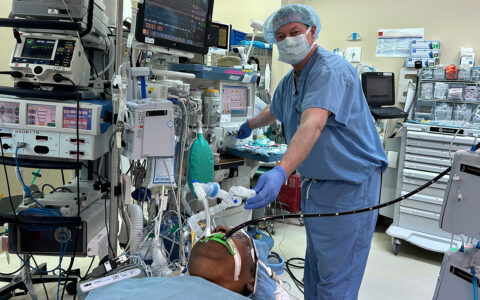Type 2 diabetes mellitus (T2DM) has been historically associated with a low total daily energy expenditure and lower energy requirements, leading to a propensity toward excessive weight gain and increased adiposity.
However, studies have not found a difference between resting rates and energy expenditures of patients with T2DM and those of a healthy population, when controlling for other factors.
Nutrition scientist Heidi J. Silver, Ph.D., R.D., led a team of researchers at Vanderbilt University Medical Center in a study examining T2DM metabolic phenotypes for aspects including diet, glycemic status, body composition, and energy expenditure. Her study specifically tested the hypothesis that the glycemic control has an impact on energy balance in adults with Type 2 diabetes
“One of the big questions in clinical nutrition practice and research is whether energy requirements differ based on a number of demographic, clinical, and body composition factors among people with similar chronic disease states,” she said. “For example, when we compare people with diabetes whose weight falls within the ‘normal’, ‘overweight’ or ‘obese’ ranges, what factors influence their energy requirements, or is there no difference?”
It has not been clear whether the potential for increased resting-energy expenditure and total daily energy expenditure in Type 2 diabetes are simply products of larger body size, a body composition favoring higher adiposity, or, alternatively, a function of metabolic abnormalities that occur as a consequence of having a progressively degenerative disease.
Type of Calories Differed
Silver’s study group comprised 78 patients with Type 2 diabetes who were compared to 19 adults with no confirmed chronic disease. They found no significant differences in calorie consumption between the two groups, but the T2DM cohort had a combined history of much higher dietary fat, protein, calcium, vitamin D, and sodium intake, and a lower carbohydrate intake, than the healthy cohort.
Blood pressure, heart rate, triglycerides and C-reactive protein levels were higher in participants with Type 2 diabetes, as well as fasting blood glucose, insulin and C-peptide.
Energy Expenditure in T2DM
To calculate the participants’ daily energy expenditure, Silver chose the gold-standard doubly-labeled-water method rather than the more frequently used indirect calorimetry.
“If you compare a person of normal weight, an overweight person and a person with obesity and diabetes, what factors change?”
Participants first drank water containing raised levels of the isotopes deuterium (2H) and oxygen-18. The rate at which the isotopes were eliminated from the blood was measured to quantify the participant’s total daily energy expenditure. This includes expenditure during activity and while at rest but not sleeping, capturing about 60-70 percent of total expenditure.
Individuals with T2DM had a significantly higher resting-energy expenditure than the healthy cohort, the investigators found. They also had a higher waist-to-hip ratio, higher visceral and subcutaneous fat, and higher insulin resistance.
Total energy expended was also higher in the group with diabetes, but the quantity did not reach significance. However, when the participants were subdivided by glycemic control status, those who did not have controlled glycemia were found to have significantly higher resting and total energy expenditure.
Thus, higher fasting glucose and HbA1C levels were significantly associated with higher total energy expended.
Adipose Impact on Energy
Lean mass, as well as visceral adipose tissue and subcutaneous adipose tissue, were measured using MRI. In the T2DM group, total lean mass was the most significant body composition predictor of higher resting-energy expenditure rates.
This cohort had three and a half times higher visceral adipose tissue than the healthy cohort and a greater adipose-to-lean ratio.
“The amounts of subcutaneous and visceral adipose tissues accounted for 76 percent of the variance in resting energy expenditure and 89 percent of the variance in total energy expenditure in participants with T2DM,” Silver said.
They also found that both visceral and subcutaneous adipose tissues played significant roles in beta cell function.
“We’ve focused on visceral adipose in diabetes for a number of years, but we are more recently discovering that subcutaneous adipose tissue has a more significant role than we thought,” Silver said. “In obesity and diabetes, the subcutaneous fat does not store excess triglycerides, but becomes dysregulated, with fats getting stored intra-abdominally and in organs and skeletal muscle.”
Effects of Uncontrolled Glycemia
When Silver further subdivided the T2DM cohort by controlled and uncontrolled glycemia, there were no significant differences in total BMI, but the uncontrolled group showed a 22 percent higher ratio of adipose-to-lean tissue, a two times higher ratio of visceral to subcutaneous adipose, and more abdominal fat overall.
Despite equivalent blood insulin levels, the group with uncontrolled glycemia had significantly more insulin resistance and less insulin sensitivity. Silver hypothesized that this contributed to having a much higher resting and total energy expenditure in the uncontrolled glycemia group.
Replacing Old Assumptions
Silver says her data debunks assumptions that a “slower metabolism” exists in overweight people with T2DM. This understanding may impact guidance from clinicians on diet and nutrition regimens that meet energy needs, as well as prescribing decisions.
“A clinician can’t easily measure abdominal, subcutaneous or visceral fat in a clinical setting without a CT scan or MRI,” she said. “However, a crucial step is to regularly pay attention to other lab values. We can measure waist circumference and measure insulin levels, as opposed to just glucose, to catch the development of hyperinsulinemia early on.”




